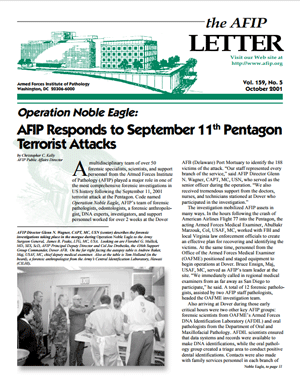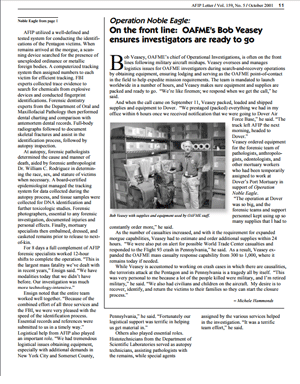OPERATION NOBLE EAGLE: AFIP RESPONDS TO SEPTEMBER 11TH PENT
OPERATION NOBLE EAGLE: AFIP RESPONDS TO SEPTEMBER 11TH PENTAGON ATTACK
by Christopher C. Kelly
October, 2001
Vol. 159, No. 5, The AFIP Letter (Armed Forces Institute of Pathology)
NOTICE: THIS WORK MAY BE PROTECTED BY COPYRIGHT
PDF HERE


A multi-disciplinary team of more than 50 forensic specialists, scientists and support personnel from the Armed Forces Institute of Pathology (AFIP) played a major role in one of the most comprehensive forensic investigations in United States history following the September 11, 2001 terrorist attack at the Pentagon in Virginia, just outside Washington, DC.
Code-named "Operation Noble Eagle," AFIP’s team of forensic pathologists, odontologists, a forensic anthropologist, DNA experts, investigators and support personnel worked for over two weeks at the Dover Air Force Base Port Mortuary at Dover, Delaware to identify the 188 victims of the attack. "Our staff represented every branch of the service," said AFIP Director Glenn N. Wagner, CAPT, MC, USN, who served as senior officer during the operation.
The investigation mobilized AFIP assets in many ways. During the hours immediately following the crash of American Airlines Flight 77 into the Pentagon, the acting Armed Forces Medical Examiner, Abubkr Marzouk, Col, USAF, MC, began working with FBI and local Virginia law enforcement officials to create an effective plan for first recovering and then identifying the victims. At the same time, personnel from the Office of the Armed Forces Medical Examiner (OAFME) positioned and staged equipment to begin operations at Dover. Bruce Ensign, LCDR, MC, USN, served as AFIP’s team leader at the site. "We immediately called in regional medical examiners from as far away as San Diego to participate," he said. A total of 12 forensic pathologists, assisted by two AFIP staff pathologists, headed the OAFME investigation team.
Also arriving at Dover during those early critical hours were two other key AFIP groups: forensic scientists from OAFME’s Armed Forces DNA Identification Laboratory (AFDIL) and oral pathologists from the Department of Oral and Maxillofacial Pathology. AFDIL scientists ensured that data systems and records were available to make DNA identifications, while the oral pathology group created a triage area to conduct dental identifications. Contacts were also made with family services personnel in each branch of the military to obtain antemortem information and reference material. Mortuary operations were fully underway by the evening of September 13, just two days after the attack.
AFIP utilized a well-defined and tested system for conducting the identifications of the Pentagon attack victims. When remains arrived at the morgue, a scanning device searched for the presence of unexploded ordinance or metallic foreign bodies. A computerized tracking system then assigned a number to each victim for efficient tracking. FBI experts collected trace evidence to search for chemicals from explosive devices and conducted fingerprint identifications. Forensic dentistry experts from the Department of Oral and Maxillofacial Pathology then performed dental charting and comparison with antemortem dental records. Full-body radiographs documented skeletal fractures and assisted in the identification process, followed by autopsy inspection.
At autopsy, forensic pathologists determined the cause and manner of death, aided by forensic anthropologist Dr. William C. Rodriguez to determine the race, sex and stature of victims for presumptive identification when necessary. A board-certified epidemiologist managed the tracking system for data collected during the autopsy process. Tissue samples were collected for DNA identification and further toxicologic studies. Forensic photographers -- essential to any forensic investigation -- documented injuries and personal effects. Finally, mortuary specialists embalmed, dressed and casketed remains prior to release to next-of-kin.
For eight days a full complement of AFIP forensic specialists worked twelve-hour shifts to complete the operation. "This is the largest mass fatality we’ve dealt with in recent years," Ensign said. "We have modalities today that we didn’t have before. Our investigation was much more technology-intensive."
Ensign noted that the entire team worked well together. "Because of the combined effort of all three services and the FBI we were very pleased with the speed of the identification process. Essential records and references were submitted to us in a timely way." Logistical help from AFIP also played an important role. "We had tremendous logistical issues obtaining equipment, especially with additional demands in New York City and Somerset County, Pennsylvania," he said. "Fortunately our logistical support was terrific in helping us get material in."
Others also played essential roles. Histotechnicians from the Department of Scientific Laboratories served as autopsy technicians assisting pathologists with the remains, while special agents assigned by the various services helped in the investigation. "It was a terrific team effort," Ensign said.
According to Rodriquez, "This was the largest mass fatality we've seen in years, and it required hundreds of decisions to be made quickly and accurately. But our biggest concern was always for the families. We worked hard to get the job done and return the victims to their loved ones."
by Christopher C. Kelly
October, 2001
Vol. 159, No. 5, The AFIP Letter (Armed Forces Institute of Pathology)
NOTICE: THIS WORK MAY BE PROTECTED BY COPYRIGHT
YOU ARE REQUIRED TO READ THE COPYRIGHT NOTICE AT THIS LINK BEFORE YOU READ THE FOLLOWING WORK, THAT IS AVAILABLE SOLELY FOR PRIVATE STUDY, SCHOLARSHIP OR RESEARCH PURSUANT TO 17 U.S.C. SECTION 107 AND 108. IN THE EVENT THAT THE LIBRARY DETERMINES THAT UNLAWFUL COPYING OF THIS WORK HAS OCCURRED, THE LIBRARY HAS THE RIGHT TO BLOCK THE I.P. ADDRESS AT WHICH THE UNLAWFUL COPYING APPEARED TO HAVE OCCURRED. THANK YOU FOR RESPECTING THE RIGHTS OF COPYRIGHT OWNERS.
PDF HERE


A multi-disciplinary team of more than 50 forensic specialists, scientists and support personnel from the Armed Forces Institute of Pathology (AFIP) played a major role in one of the most comprehensive forensic investigations in United States history following the September 11, 2001 terrorist attack at the Pentagon in Virginia, just outside Washington, DC.
Code-named "Operation Noble Eagle," AFIP’s team of forensic pathologists, odontologists, a forensic anthropologist, DNA experts, investigators and support personnel worked for over two weeks at the Dover Air Force Base Port Mortuary at Dover, Delaware to identify the 188 victims of the attack. "Our staff represented every branch of the service," said AFIP Director Glenn N. Wagner, CAPT, MC, USN, who served as senior officer during the operation.
The investigation mobilized AFIP assets in many ways. During the hours immediately following the crash of American Airlines Flight 77 into the Pentagon, the acting Armed Forces Medical Examiner, Abubkr Marzouk, Col, USAF, MC, began working with FBI and local Virginia law enforcement officials to create an effective plan for first recovering and then identifying the victims. At the same time, personnel from the Office of the Armed Forces Medical Examiner (OAFME) positioned and staged equipment to begin operations at Dover. Bruce Ensign, LCDR, MC, USN, served as AFIP’s team leader at the site. "We immediately called in regional medical examiners from as far away as San Diego to participate," he said. A total of 12 forensic pathologists, assisted by two AFIP staff pathologists, headed the OAFME investigation team.
Also arriving at Dover during those early critical hours were two other key AFIP groups: forensic scientists from OAFME’s Armed Forces DNA Identification Laboratory (AFDIL) and oral pathologists from the Department of Oral and Maxillofacial Pathology. AFDIL scientists ensured that data systems and records were available to make DNA identifications, while the oral pathology group created a triage area to conduct dental identifications. Contacts were also made with family services personnel in each branch of the military to obtain antemortem information and reference material. Mortuary operations were fully underway by the evening of September 13, just two days after the attack.
AFIP utilized a well-defined and tested system for conducting the identifications of the Pentagon attack victims. When remains arrived at the morgue, a scanning device searched for the presence of unexploded ordinance or metallic foreign bodies. A computerized tracking system then assigned a number to each victim for efficient tracking. FBI experts collected trace evidence to search for chemicals from explosive devices and conducted fingerprint identifications. Forensic dentistry experts from the Department of Oral and Maxillofacial Pathology then performed dental charting and comparison with antemortem dental records. Full-body radiographs documented skeletal fractures and assisted in the identification process, followed by autopsy inspection.
At autopsy, forensic pathologists determined the cause and manner of death, aided by forensic anthropologist Dr. William C. Rodriguez to determine the race, sex and stature of victims for presumptive identification when necessary. A board-certified epidemiologist managed the tracking system for data collected during the autopsy process. Tissue samples were collected for DNA identification and further toxicologic studies. Forensic photographers -- essential to any forensic investigation -- documented injuries and personal effects. Finally, mortuary specialists embalmed, dressed and casketed remains prior to release to next-of-kin.
For eight days a full complement of AFIP forensic specialists worked twelve-hour shifts to complete the operation. "This is the largest mass fatality we’ve dealt with in recent years," Ensign said. "We have modalities today that we didn’t have before. Our investigation was much more technology-intensive."
Ensign noted that the entire team worked well together. "Because of the combined effort of all three services and the FBI we were very pleased with the speed of the identification process. Essential records and references were submitted to us in a timely way." Logistical help from AFIP also played an important role. "We had tremendous logistical issues obtaining equipment, especially with additional demands in New York City and Somerset County, Pennsylvania," he said. "Fortunately our logistical support was terrific in helping us get material in."
Others also played essential roles. Histotechnicians from the Department of Scientific Laboratories served as autopsy technicians assisting pathologists with the remains, while special agents assigned by the various services helped in the investigation. "It was a terrific team effort," Ensign said.
According to Rodriquez, "This was the largest mass fatality we've seen in years, and it required hundreds of decisions to be made quickly and accurately. But our biggest concern was always for the families. We worked hard to get the job done and return the victims to their loved ones."